Controlling heat in your solar oven guarantees consistently delicious meals by maintaining ideal cooking temperatures between 300°F and 400°F. You'll need to adjust your oven's position every 30 minutes to follow the sun and use dark, lidded cookware for better heat absorption. Since solar cooking takes 1.5 to 3 times longer than conventional methods, monitoring temperature helps prevent undercooking while the gentle solar heat rarely burns food. Weather conditions like humidity and ambient temperature affect cooking times, so using thermometers and proper insulation techniques keeps your meals on track. Understanding these heat control basics opens the door to mastering perfect sun-baked dishes.
Understanding Solar Oven Heat Patterns
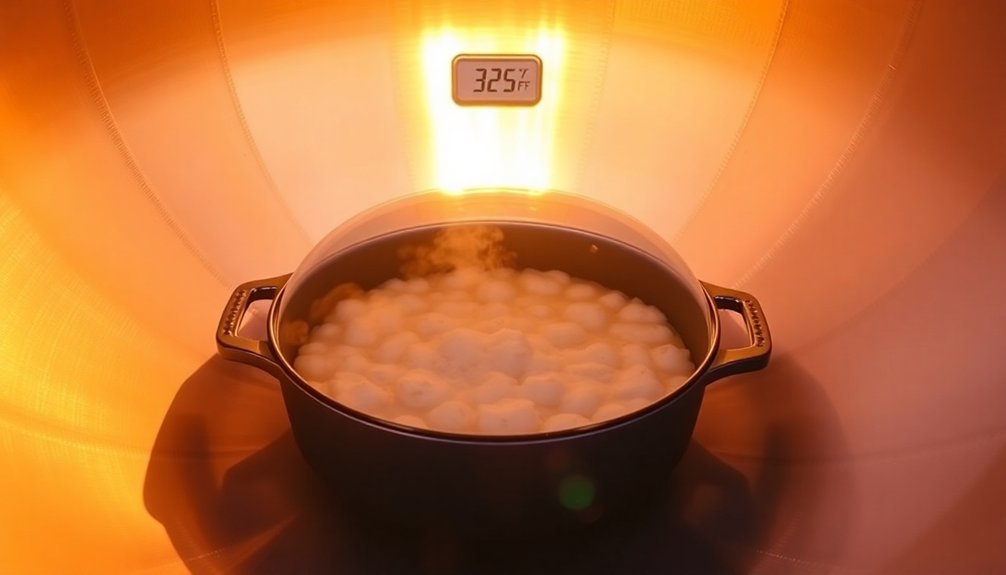
While solar ovens harness the sun's energy through clever design, understanding their heat patterns is essential for successful cooking.
You'll find that temperatures peak around noon and gradually decrease afterward, following the sun's daily arc. Your oven's geometry, particularly its reflectors and seven-faced design, helps concentrate sunlight onto cooking surfaces.
You'll need to monitor how external factors affect your cooking. Wind can quickly steal heat, so choose a sheltered spot. Optimal cooking occurs during prime cooking hours from 10 AM to 4 PM. The ambient temperature should be above 75°F for best performance.
Keep adjusting your oven's position to track the sun – this maintains consistent heat levels. For precise temperature control, you can use thermocouples to monitor changes.
Remember that season and latitude influence cooking times; box-type ovens typically reach 325-350°F in ideal conditions.
Optimal Temperature Settings
Now that you understand solar oven heat patterns, let's focus on maximizing your cooking temperatures. Your solar oven's type determines its temperature range: box-style ovens reach 160°F to 400°F, parabolic models can soar to 800°F, and panel cookers operate between 200°F to 300°F.
You'll get the best results by maintaining temperatures between 300°F to 400°F for most dishes. To achieve this, position your oven directly in the sun and adjust it every 30 minutes. The best cooking window is during peak UV hours from 11:00 AM to 3:00 PM.
Use dark-colored cookware to boost heat absorption, and guarantee proper insulation with materials like cotton balls or newspapers. Remember to keep the oven in a wind-sheltered spot to prevent heat loss.
For food safety, you'll need to maintain temperatures above 180°F, so use a digital thermometer to monitor without opening the oven.
Cooking Time Adjustments
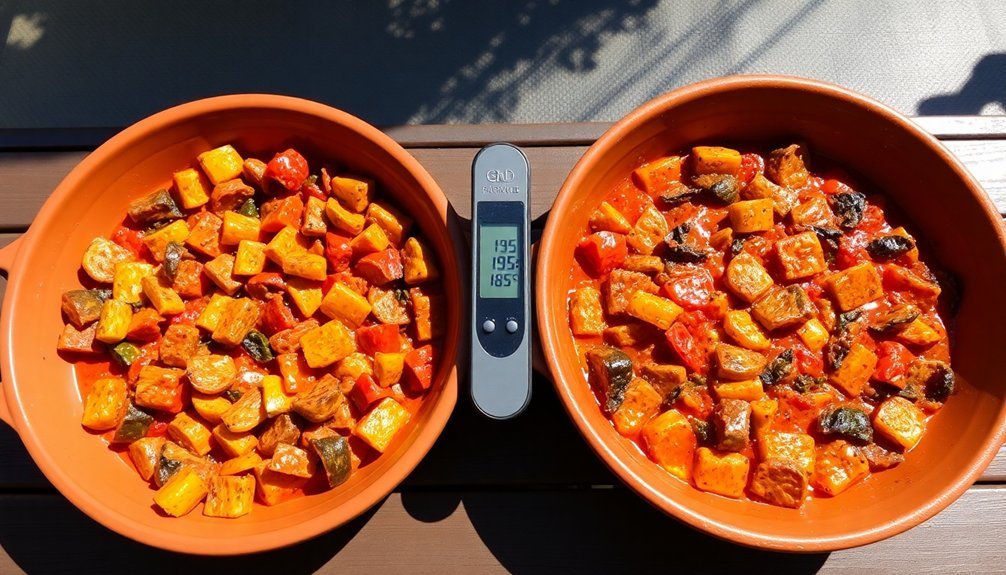
Since solar cooking operates differently from conventional ovens, you'll need to plan for longer cooking times – typically 1.5 to 3 times what traditional recipes suggest.
For best results, schedule your cooking between 11:00 am and 3:00 pm when the sun's position is ideal. During summer months, you can take advantage of extended daylight hours for additional cooking time before and after this window.
You'll find that different foods require varying durations: eggs and melted cheese take under an hour, while cookies and quick breads need 1-1.5 hours.
Plan on 2-2.5 hours for fish and cut-up meats, 3-3.5 hours for whole chickens and soups, and up to 7 hours for dried beans and large cuts of meat.
Remember to use dark cookware for faster cooking, and adjust your oven every 30 minutes to track the sun.
Don't worry about overcooking – solar ovens rarely burn food.
Monitoring Your Solar Meal
Successfully tracking your solar meal requires more than just setting a timer and walking away.
You'll need to monitor temperature changes, heat distribution, and solar positioning to guarantee your food cooks evenly and safely. Modern apps and tools make this process easier by providing real-time data and alerts when temperatures fall outside ideal ranges. Solar cooking maintains optimal performance at 80C to 90C when starting most dishes.
Three essential monitoring steps for perfect solar cooking:
- Check temperature readings every 15-20 minutes using thermocouples or data loggers connected to your mobile device.
- Adjust the oven's position to follow the sun's movement, maintaining consistent heat levels throughout cooking.
- Monitor weather conditions and make necessary adjustments to reflector angles and cooking times based on cloud cover or wind.
Keep safety in mind by using proper protection when handling hot surfaces and avoiding direct eye contact with reflective surfaces.
Weather Impact On Baking
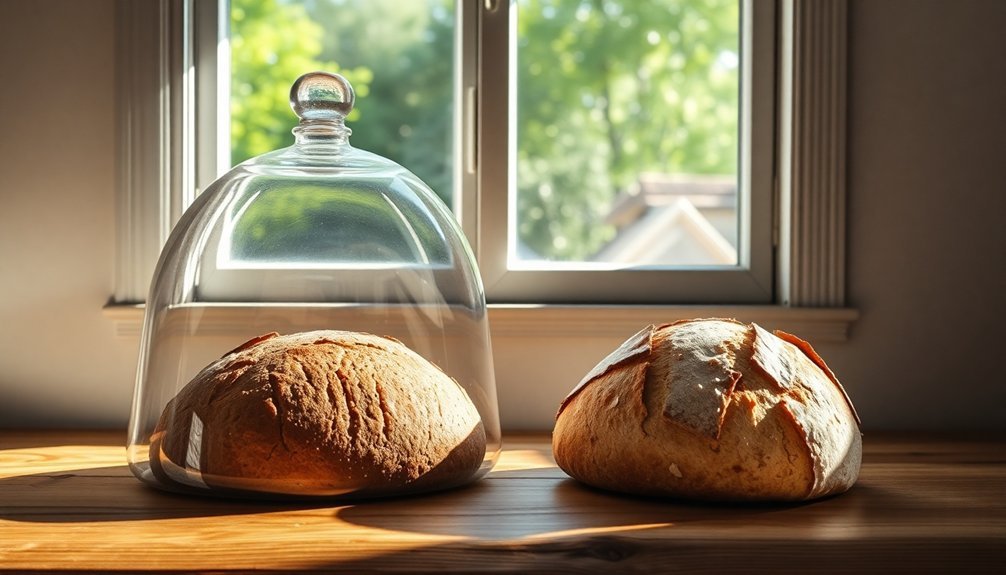
Weather conditions can dramatically affect your solar baking results, with humidity, air temperature, and altitude playing essential roles. High humidity will extend your bake times and cause your baked goods to flatten more quickly as dry ingredients absorb excess moisture.
You'll need to reduce liquid content in your recipes to compensate.
Air temperature directly impacts how your fats behave – warmer conditions mean faster-melting butter in your doughs.
If you're baking at higher altitudes, you'll notice your goods rise faster but lose moisture more quickly, often creating large bubbles and coarse textures.
To manage these challenges, store your dry ingredients in the fridge, adjust your recipes' leavening agents, and consider using baking stones for temperature stability.
Remember to bring ingredients to room temperature before starting for consistent results.
Temperature Control Best Practices
Managing kitchen temperatures goes beyond weather considerations – it's about mastering the interplay of heat and food.
You'll need to understand how different cooking methods affect your ingredients and adjust accordingly. Whether you're searing meat or slow-cooking stews, controlling heat determines your meal's success.
To achieve ideal results in your sun-baked dishes, follow these essential practices:
- Preheat your cooking surface thoroughly before adding ingredients to guarantee even heat distribution.
- Monitor internal food temperatures using a reliable thermometer to assure both safety and desired doneness.
- Allow cooked meats to rest at room temperature, letting the juices redistribute for maximum flavor.
Remember that temperature control isn't just about cooking – proper storage temperatures for ingredients and maintaining consistent conditions during food preparation are equally important for achieving perfect results.
Mastering Heat Retention Techniques
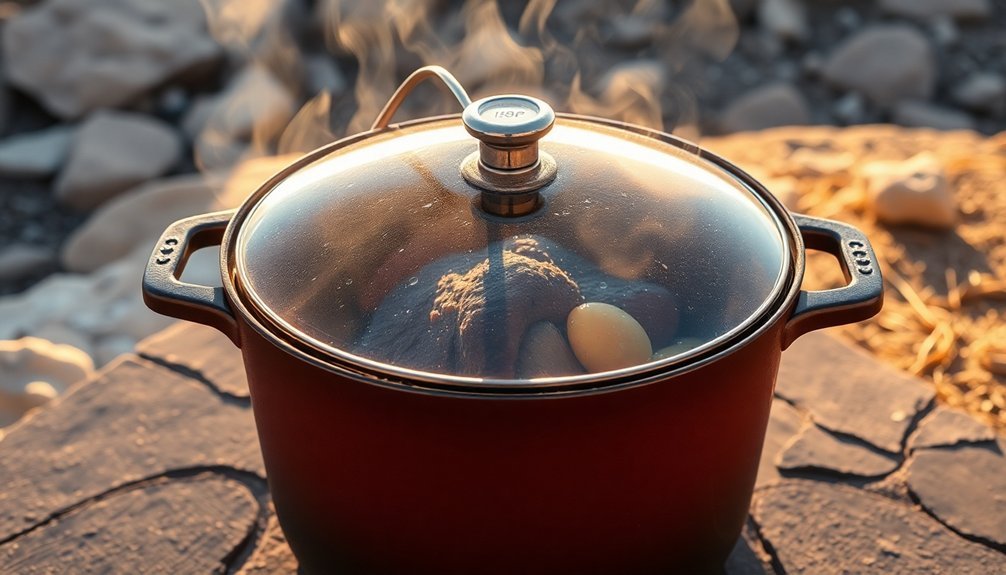
You'll maximize your sun-baked meal's heat retention by strategically positioning your cookware to capture and hold the most sunlight throughout the cooking process.
When you check your food, lift the lid quickly and efficiently to prevent excessive heat loss, as every second with an open container reduces cooking temperature considerably.
Keep your cooking setup well-insulated using readily available tools like foam pads, reflective materials, or even bundled towels to maintain consistent cooking temperatures.
Strategic Positioning Matters Most
Successful solar cooking hinges on mastering the art of strategic positioning.
You'll need to face your solar oven directly south and adjust its angle throughout the day to maintain ideal sun exposure. Keep those reflective surfaces spotless to maximize heat capture and use your temperature gauge to monitor the impact of positioning adjustments.
For the best results in sun-baked cooking:
- Rotate and tilt your oven frequently to track the sun's movement, ensuring consistent temperature.
- Create effective heat zones by adjusting exposure time and angle – perfect for different cooking methods.
- Monitor internal temperature closely and minimize oven opening to maintain steady heat levels.
Timing Your Lid Lifts
To maintain ideal cooking temperatures in your solar oven, carefully time your lid lifts and implement smart heat retention strategies. You'll need to minimize opening the oven, as each peek releases precious heat. When you must check your food, combine tasks by wiping away condensation during the same opening.
| Action | Impact |
|---|---|
| Using lidded dishes | Retains moisture and heat |
| Reducing liquids | Minimizes condensation buildup |
| Leaving slight lid gap | Allows excess steam to escape |
For best results, don't lock lids too tightly – leave a small airspace for moisture release. You can insert a matchstick between the glass and gasket to help manage steam. Remember to reduce your recipe's liquid content by 1/4 to 1/2 cup to prevent excessive moisture buildup, which can affect cooking temperatures and times.
Insulation Tools and Tricks
Mastering heat retention in your solar oven requires the right combination of tools and techniques.
You'll want to focus on insulation methods that trap heat effectively while preventing temperature fluctuations. Cast iron cookware serves as your best ally, thanks to its superior heat retention properties, while multiple layers of aluminum foil and cloth wrappings create additional thermal barriers.
- Use cast iron pots with heavy-duty lids to maintain consistent temperatures and guarantee even cooking throughout your dishes.
- Wrap your cookware in aluminum foil, then add a layer of cloth or towel for maximum insulation during longer cooking sessions.
- Divide larger portions into smaller batches to maintain steady temperatures, and consider using insulated containers if you need to transport your solar-cooked meals.
Frequently Asked Questions
Can I Cook Multiple Dishes at Different Temperatures Simultaneously?
You can cook multiple dishes simultaneously by finding an average temperature that works for all dishes. Use convection settings if available, adjust cooking times up by 15%, and place items strategically on different racks.
Does Food Cooked in a Solar Oven Require Different Seasoning Amounts?
You don't need to change your seasoning amounts when using a solar oven. While the slow cooking process may enhance flavor distribution, you'll still use the same quantities as you would with conventional cooking methods.
How Do Reflective Surfaces Affect Cooking Temperature After Prolonged Use?
You'll find that well-maintained reflective surfaces continue directing sunlight efficiently over time, but dirt or wear can reduce their effectiveness. Regular cleaning helps maintain consistent cooking temperatures during extended use of your solar oven.
What Materials Make the Best Heat-Retaining Cookware for Solar Ovens?
You'll get the best heat retention using dark aluminum or enamelware pots. They'll heat quickly and maintain temperature well. If you've got cast iron, it works great too but takes longer to heat up.
Can Nighttime Temperature Drops Affect Partially Cooked Food Left Overnight?
Yes, you shouldn't leave partially cooked food overnight. Even if temperatures drop, the damage's already done. Bacteria multiply rapidly during warm periods and produce toxins that won't be eliminated by later cooking.
In Summary
You'll find that mastering heat control in solar cooking transforms simple ingredients into perfectly sun-baked meals. By understanding temperature patterns, making weather-based adjustments, and implementing proper heat retention techniques, you're set for success. Don't forget to monitor your food closely and adapt cooking times as needed. With practice, you'll harness the sun's power to create consistently delicious dishes while saving energy.
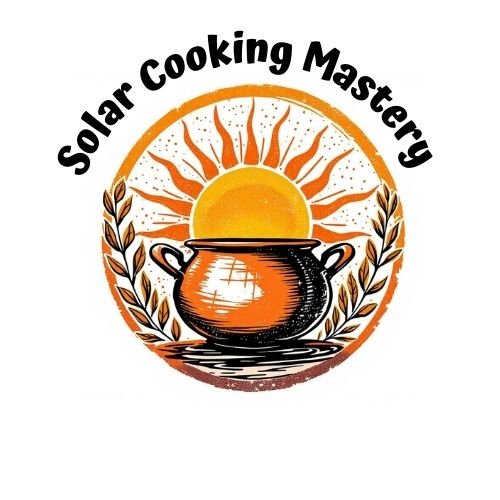
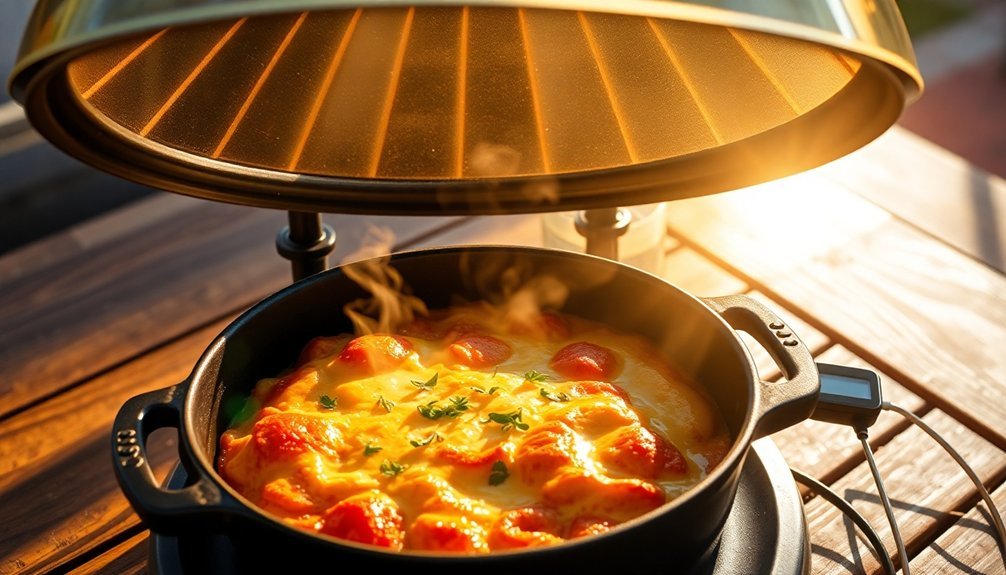
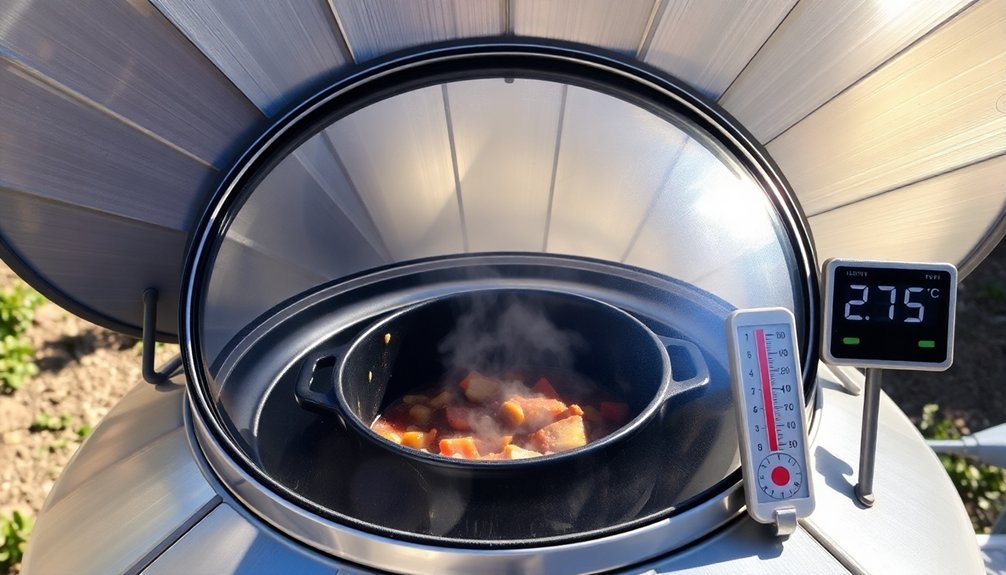
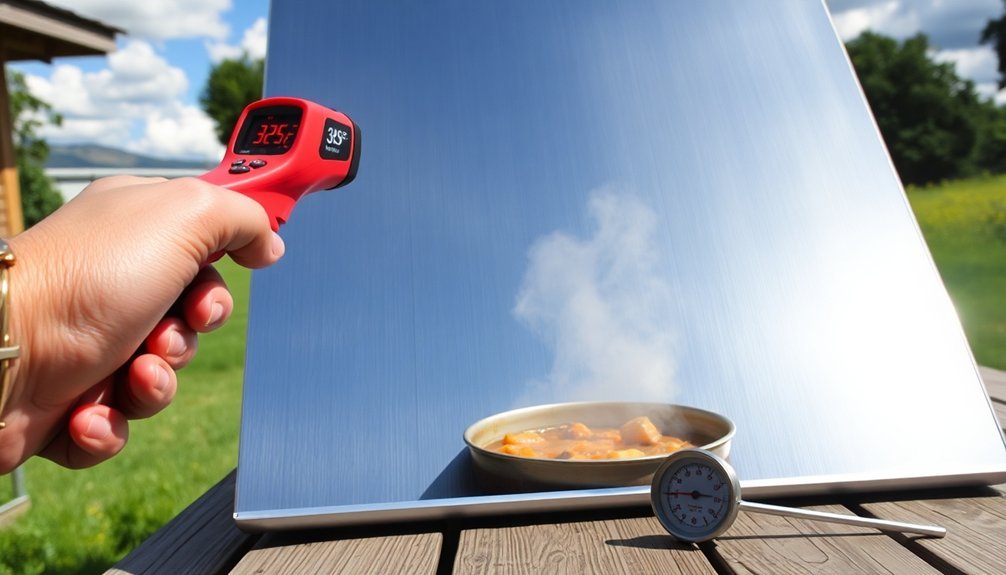
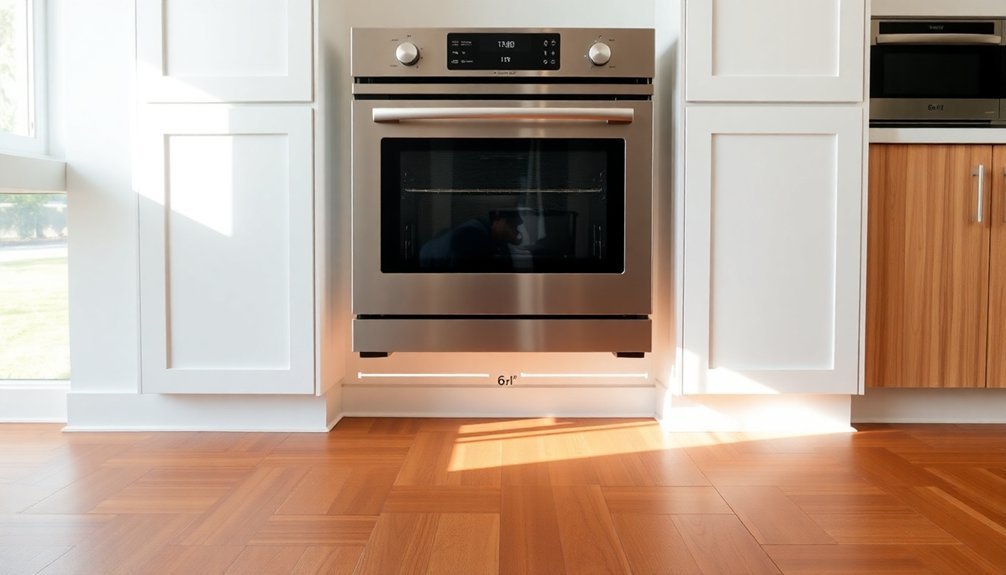
Leave a Reply